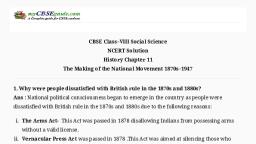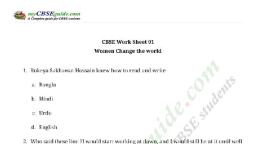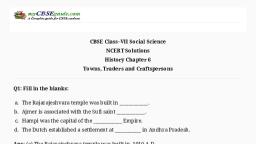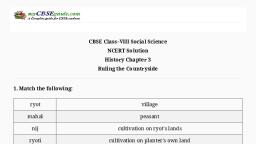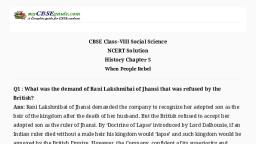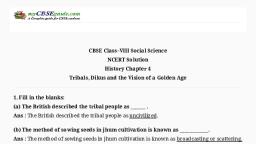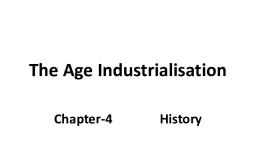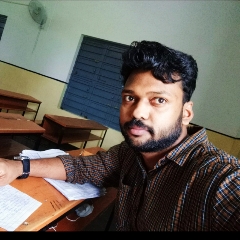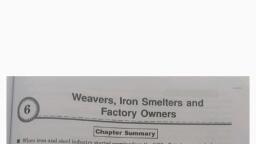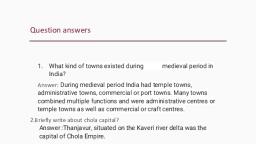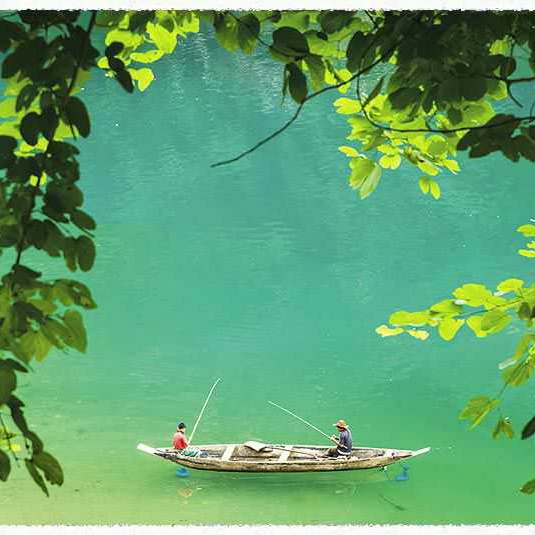Page 1 :
CBSE Class–VIII Social Science, NCERT Solutions, History Chapter 7, Weavers, Iron Smelters and Factory Owners, , Q1. What kinds of cloth had a large market in Europe?, Ans:, 1. Cotton and silk textiles had a huge market in Europe. Indian textiles were by far the most, popular, both for their fine quality and exquisite craftsmanship., 2. Different varieties of Indian textiles were sold in the Western markets; for example, the, printed cotton cloth called Chintz, cossaes or khassa and bandanna had a large market in, Europe., 3. From the 1680s, there started a craze for printed Indian cotton textiles in England and, Europe, mainly for their exquisite floral designs, fine texture and relative cheapness. Rich, people of England including the Queen herself wore clothes of Indian fabric., , Q2. What is jamdani?, Ans: Jamdani is a fine muslin on which decorative motifs are woven on the loom, typically in, grey and white. In Jamdani, often a mixture of cotton and gold thread is used. Dacca in, Bengal and Lucknow in the United Provinces were the most important centres of jamdani, weaving., , Q3. What is bandanna?, Ans: Bandanna is a brightly coloured and printed scarf for the neck or head. Originally, the, term derived from the Hindi word ‘bandhna’ and referred to a variety of brightly coloured, cloth produced through a method of tying and dying., , Q4. Who are the Agarias?, Ans: The Agarias are an Indian community of iron smelters. It was a group of men and, women carrying basket-loads of iron. After a series of famines, a lot of Agarias deserted their, villages and never worked as smelters again in the late nineteenth century., , Material downloaded from myCBSEguide.com., , 1/5
Page 2 :
Q5. Fill in the blanks:, (a) The word chintz comes from the word _____., Ans: (a) The word chintz comes from the word chhint., (b) Tipu’s sword was made of_________ steel., Ans: (b) Tipu's sword was made of Wootz steel., (c) India’s textile exports declined in the _________century., Ans: (c) India's textile exports declined in the nineteenth century., , Q6. How do the names of different textiles tell us about their histories?, Ans:, European traders first saw fine cotton cloth from India carried by Arab merchants in, Mosul in present-day Iraq. So they began referring to all finely woven textiles as, "muslin” – a word that acquired wide currency., When the Portuguese first came to India in search of spices they landed in Calicut on, the Kerala coast in South West India. The cotton textiles which they took back to, Europe came to be known as calico, which is derived from Calicut., Printed cotton cloths called chintz, cossaes or khassa and bandanna were also in great, demand. The chintz is derived from the Hindi word 'chhint', a cloth with small and, colourful flowery designs., The word bandanna is referred to any brightly coloured and printed scarf for the, neck or head. Originally, the term derived from the word ‘bandhna’ (Hindi for tying), and referred to a variety of brightly coloured cloth produced through a method of, tying and dying., The other clothes were noted by their place of origin such as Kazimbazaar, Patna,, Orissa, Calcutta, etc., , Q7. Why did the wool and silk producers in England protest against the import of, Indian textiles in the early eighteenth century?, Ans:, 1. By the early eighteenth century, worried by the popularity of Indian textiles, the wool, and silk makers in England began protesting against the import of Indian cotton textiles., Material downloaded from myCBSEguide.com., , 2/5
Page 3 :
2. Textile industry had just begun to develop in England in the early 18th century. The wool, and silk producers in England found themselves unable to compete with Indian textiles., They wanted to secure a market within the country by preventing the entry of Indian, textiles., 3. The first to grow under government protection was the calico printing industry. Indian, designs were imitated and printed in England on white muslin or plain unbleached, Indian cloth., 4. Competition from Indian textiles also led to the invention of the spinning jenny and the, use of the steam engine for textile development, thereby making the wool and silk, producers in England more independent., , Q8. How did the development of cotton industries in Britain affect textile producers in, India?, Ans: The development of cotton industries in Britain affected textile producers in India in, several ways:, i. Competition - Indian textiles had to compete with British textiles in European and, American markets., ii. High duties - Exporting textiles to England became increasingly difficult due to very high, duties imposed on Indian textiles imported into Britain., iii. Capture of foreign markets- By the beginning of the nineteenth century, English, made cotton textiles successfully eliminated Indian goods from their traditional markets, in Africa, America and Europe. Thousands of weavers in India became unemployed., Bengal weavers were the worst hit. The English and European companies stopped buying, Indian textiles, and their agents no longer gave out advances to weavers to secure, supplies., iv. Capture of the Indian market - British cotton cloth flooded Indian markets by the 1830s., Two-third of all cotton clothes worn by Indians were made of cloth produced in Britain, by the 1880s. This greatly affected both the weavers and the spinners., Thus, in the nineteenth century Indian textiles declined and thousands of Indian weavers, and spinners lost their livelihood., , Q9. Why did the Indian iron smelting industry decline in the nineteenth century?, Material downloaded from myCBSEguide.com., , 3/5
Page 4 :
Ans: The Indian iron smelting industry declined in the nineteenth century for the following, reasons:, i. The new forest laws of the colonial government prevented people from entering the, reserved forests. Now it became difficult for the iron smelters to find wood for charcoal., Getting iron ore was also a big problem. Hence, many gave up their craft and looked for, other jobs., ii. In some areas, the government did grant access to the forest. But the iron smelters had to, pay a very high tax to the forest department for every furnace they used. This reduced, their income and discouraged them from the development of their business., iii. The late 19thcentury iron and steel were being imported from Britain. Ironsmiths in India, began using the imported iron to manufacture utensils and implements. This inevitably, lowered the demand for iron produced by local smelters., iv. In the late nineteenth century, a series of famines devastated the dry tracts of India. As a, result, many of the local smelters, for example, the Agarias stopped work, deserted their, villages, and migrated, looking for some other work to survive the hard times., By the early twentieth century, the artisans producing iron and steel faced new competition, from iron and steel factories., , Q10. What problems did the Indian textile industry face in the early years of its, development?, Ans: In the early years of its development the Indian textile industry had faced the following, problems:, 1. Indian textiles now had to compete with British textiles in the European and American, markets. It found it difficult to compete with the cheap textiles imported from Britain., 2. Exporting textiles to England also became increasingly difficult since very high duties, were imposed on Indian textiles imported into Britain.In most countries, governments, supported industrialisation by imposing heavy duties on imports. This eliminated, competition and protected infant industries. The colonial government in India refused, such protection to local industries., 3. English made cotton textiles successfully ousted Indian goods from their traditional, markets in Africa, America and Europe by the beginning of the nineteenth century., Material downloaded from myCBSEguide.com., , 4/5
Page 5 :
Thousands of weavers in India were now thrown out of employment., 4. Bengal weavers were the worst hit. English and European companies stopped buying, Indian goods and their agents no longer gave out advances to weavers to secure supplies., Distressed weavers wrote petitions to the government to help them., 5. By the 1880s, two-thirds of all the cotton clothes worn by Indians were made of cloth, produced in Britain. This affected not only specialist weavers but also spinners., 6. Also, thousands of rural women who made a living by spinning cotton thread were, rendered jobless., , Q11. What helped TISCO expand steel production during the First World War?, Ans:, i. The First World War broke out in 1914, ii. Steel produced in Britain now had to meet the demands of the war in Europe., iii. So imports of British steel into India declined dramatically and the Indian Railways, turned to TISCO for the supply of rails., iv. TISCO had to produce shells and carriage wheels for the war as the war dragged on for, several years,, v. The colonial government was buying 90 percent of the steel manufactured by TISCO by, 1919., vi. TISCO became the biggest steel industry within the British Empire over time., , Material downloaded from myCBSEguide.com., , 5/5

